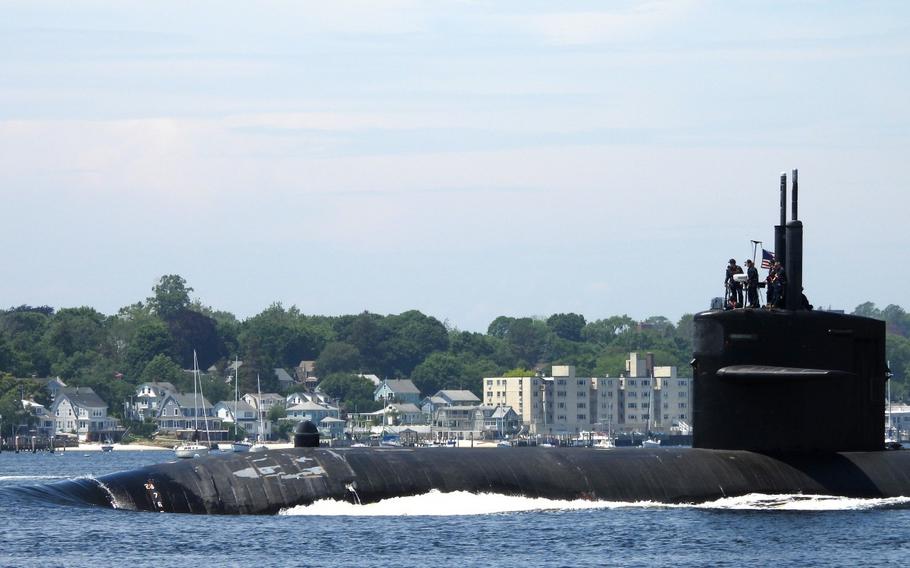
Constructed by Newport News Shipbuilding and General Dynamics Electric Boat Division, the Los Angeles-class nuclear-powered attack submarine USS Providence is a primary underwater asset of the Navy. (Hartford Courant/TNS)
(Tribune News Service) — The $95 billion Ukraine, Israel and Taiwan aid package headed for approval Tuesday by the U.S. Senate contains a financial boost for submarine production at Electric Boat and dozens of supporting businesses scattered across the state.
Tucked into the bill that survived a far-right Republican challenge in the U.S. House late last week is $2 billion for the businesses that make up what is known as the submarine industrial base, suppliers and contractors struggling to meet aggressive new U.S. Navy sub building targets.
That industrial base investment matches an extraordinary $3 billion from the Australians in support of AUKUS, the recently signed Australia, United Kingdom, U.S. Indo-Pacific security agreement, and another $6 billion stimulus the Pentagon proposes spending in the fiscal 2025 defense budget.
The stimulus money, which has increased dramatically year-over-year, is intended to turbocharge a national shipbuilding base that has been idle for years as the Pentagon tries to rebuild a submarine fleet capable of meeting increasingly aggressive Chinese expansionism in Eastern Asia.
Decades of flat, post-cold war spending shrunk the U.S. fleet by half. It also depleted the ranks of welders, shipfitters and riggers who build ships at the Pentagon’s prime submarine contractor, the Electric Boat Division of General Dynamics in Groton, as well as the companies that supply them with parts, materials and others services.
As construction surges, the Navy is watching whether EB — and thousands of manufacturers in its supply chain — can hire and expand production quickly enough to meet not only U.S. fleet requirements, but the U.S. commitment to sell from three to five Virginal class, nuclear-powered attack submarines to Australia under AUKUS.
There is language in AUKUS that authorizes whoever is U.S. president at the time of the proposed Australian sales to kill the deal if such a reduction in the U.S. fleet could negatively affect the national defense.
Against that backdrop, Congress and the Navy have committed to building dozens of Columbia ballistic missile and Virginia attack submarines, the stealthiest, most technologically advanced and expensive weapons platforms ever. The plan calls for a dozen Columbias and 66 Virginias.
To meet its national defense and AUKUS targets, the Navy says it needs EB and its shipbuilding partner, the Newport News Shipbuilding Division of Huntington Ingalls Industries, to deliver two Virginias and one Columbia a year by 2028.
U.S. Rep Joe Courtney, D-2, and a powerful voice in naval affairs as ranking member of the Seapower Subcommittee of the U.S. House Armed Services Committee, said in a recent letter to colleagues that EB was producing 1.4 Virginias a year, a build rate that exceeds the Navy’s production curve.
“The Navy believes that their plan in terms of investing in the submarine industrial base will allow them to execute AUKUS with some confidence,” Courtney said in an interview.
However, Courtney and other committee members are challenging a Navy decision to break from recent tradition and fund one rather than two Virginia submarines in the upcoming defense bill.
They argue the decision sends the wrong message to EB and hundreds of other businesses in the supply chain that have shown a willingness to invest billions of dollars in personnel and equipment in the expectation that the Navy will buy submarines at a constant rate over coming decades.
“I am seeing remarkable growth within the submarine industrial base that should not be overlooked,” Courtney said in the letter to colleagues. “That is why a bipartisan group of members and I strongly support maintaining procurement stability in Navy shipbuilding, rather than cutting procurement which will only exacerbate challenges on our Navy and industrial base.”
In order to meet Naval production goals, EB has invested billions of dollars in Groton and Quonset Point, R.I. shipyards and in 2023, hired a record number — more than 5,300 — new employees. At the same time, it retained 88% of its workforce and was on pace to hire another 5,200 new employees in 2024. The shipyard also signed a 5-year contract with shipyard unions that includes a 21.4% pay increase over the contract term.
©2024 Hartford Courant.
Visit courant.com.
Distributed by Tribune Content Agency, LLC.